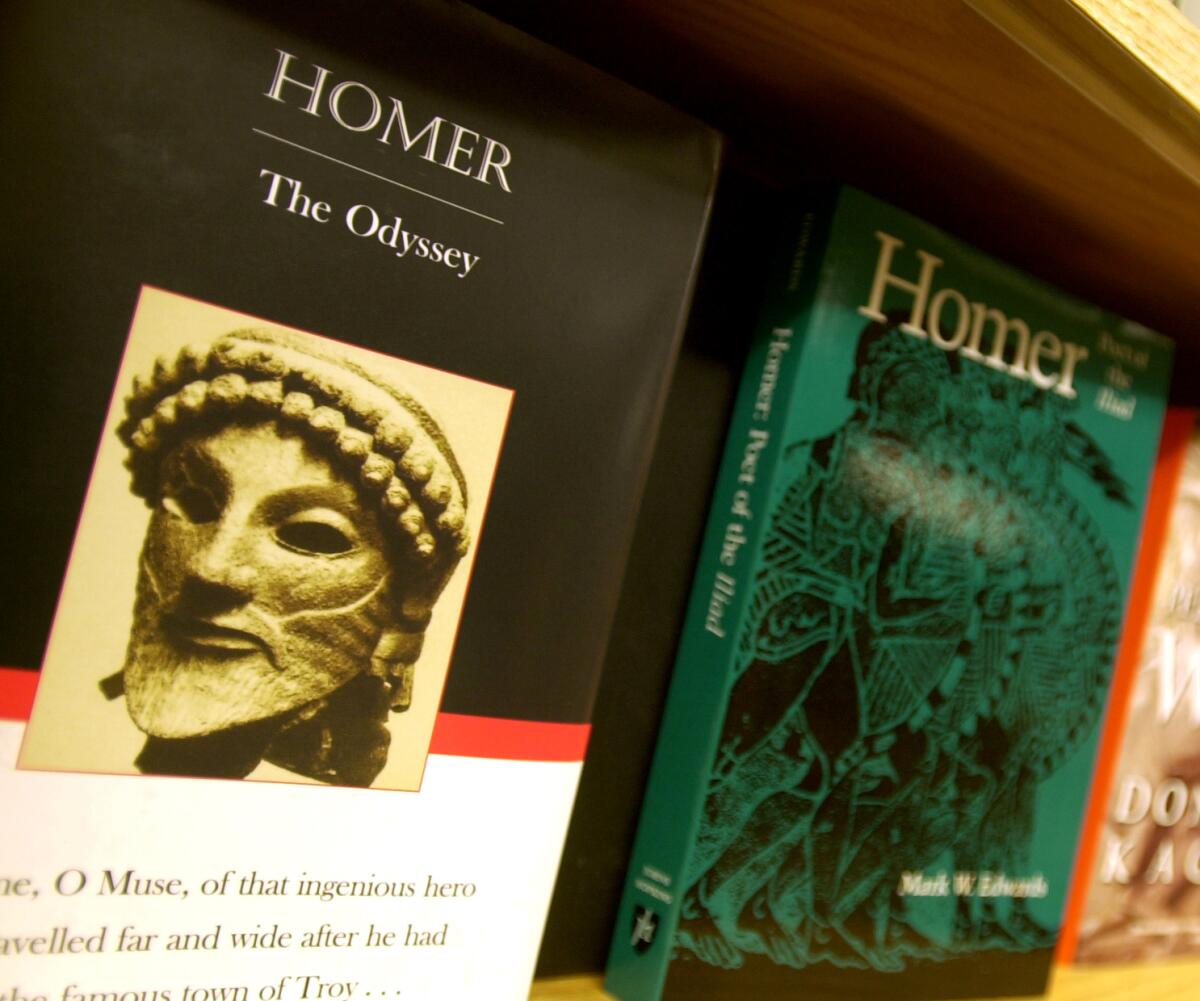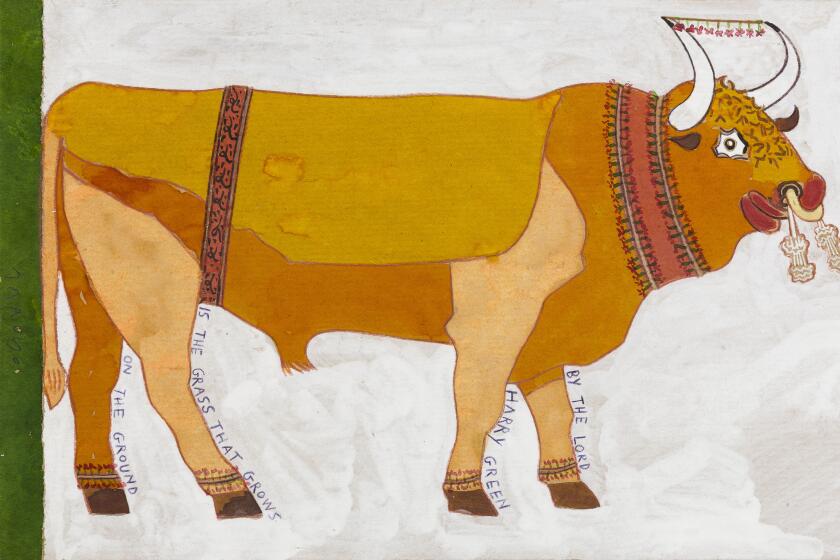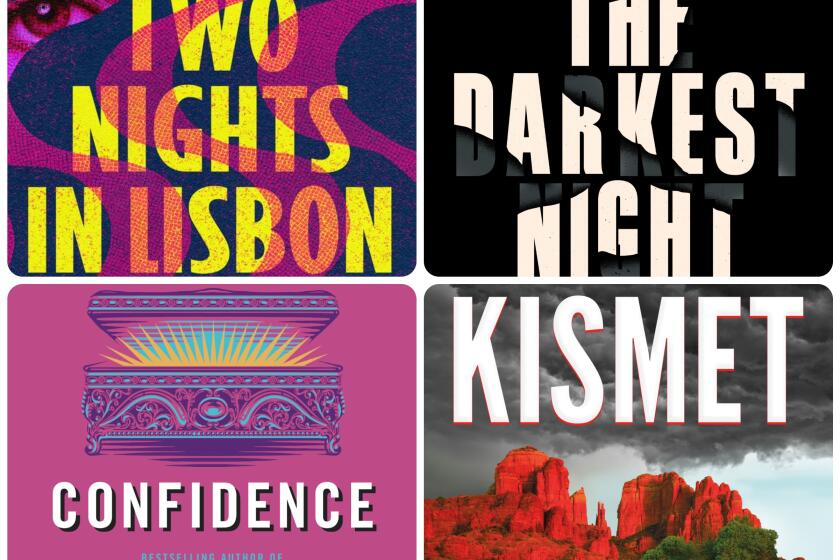Review: A hilarious, righteous transgender remix of ‘The Odyssey’ blows up the literary canon

- Share via
On the Shelf
Didn't Nobody Give a S— What Happened to Carlotta
By James Hannaham
Little Brown: 352 pages, $28
If you buy books linked on our site, The Times may earn a commission from Bookshop.org, whose fees support independent bookstores.
James Hannaham is one of America’s most versatile artists. His irreverent critiques of American culture range from visual art mocking pompous art gallery installations and racist signage to fiction that includes the novel “Delicious Foods,” a modern-day allegory about Black slavery and self-determination narrated in part by Scotty, the crack cocaine to which a character is addicted. While satire is one of his strong suits, Hannaham also riffs on classic literature, most recently in 2021’s “Pilot Impostor,” a melange of fiction and nonfiction, poetry and prose, rant and art that is a direct response to 20th century Portuguese poet Fernando Pessoa.
For his third novel, out this week, Hannaham combines both modes — wicked satire and selected allusions to “The Odyssey” and its progeny — to create a scathing, heartbreaking takedown of the carceral system, “Didn’t Nobody Give a S— What Happened to Carlotta.”
It’s “audition number five with the New York State Board of Parole” for Carlotta Mercedes, who’s been incarcerated for two decades on an aggravated assault and armed robbery conviction. Carlotta, a mixed-race trans Blatina, has spent most of her sentence in solitary confinement for what the correctional officers call bad behavior, “but they definition a bad behavior’s if you scream when a CO whupping yo ass like a Betty Crocker fudge cake.” Nonetheless, the fifth time seems to be the charm as Carlotta, whose deadname was Dustin Chambers, is paroled over the protests of the victim’s family and, five months later, unceremoniously dumped at an Ithaca bus terminal. She disembarks at New York City’s Port Authority Bus Terminal just in time for the Fourth of July weekend, 2015.
James Hannaham has made a career out of being unpredictable.
New York is a multisensory immersion for Carlotta: Asian and white businessmen spewing from skyscrapers; Latin, club and hip-hop music pumping from SUVs; the smells of familiar foods that evoke her childhood. In Manhattan and later in Brooklyn, Carlotta, who in prison assumed the first and middle name of 20th century actress Mercedes McCambridge, seems like a trans female Odysseus returned from the Trojan Wars and trying to find her way home. This allows for some hilarious and pointed observations about how much has changed since 1995: “She walked down Greene, staring at all the pale pedestrians, their babies, and their tiny dogs. Linen-white mothers shoved strollers over the concrete and Black women pushed yet more white children in other strollers Dag, what happened, did they cancel Black chillun round here?”

Carlotta’s prison-inflected Black vernacular may draw criticism from those who find it challenging to parse — terms like “LORs” or “chomo” might require a prison slang dictionary — or who question whether Hannaham, a Black gay man, can authentically channel a Black Colombian trans woman’s experience. But the author has always done the work required to write diverse characters. Here he uses a consistent vernacular authentic to Carlotta’s origins and transformation in ways that other writers, going as far back as Sapphire’s controversial novel “Push,” have failed to achieve. Carlotta’s bold voice hooks readers from the beginning, making them willing ride-or-dies.
When Carlotta finally arrives at her childhood home in Brooklyn’s Fort Greene neighborhood, the Chambers family, assembled in the multistory brownstone to celebrate Carlotta’s niece’s dubious singing talents and, later that weekend, at a “partywake” for a deceased family friend, seem like the Lotus Eaters of Homer’s epic, partying so hard they completely overlook Carlotta and the changes she’s undergone: “She doped out how oblivious or unmoved her family had been during all the earthquakes of her life story. They had just let time pass, not totally without caring, but without caring enough or not being brave enough to ask the right questions.”
Had the Chambers family asked, they would have learned what the reader knows through Carlotta’s boisterous recollections, which often hijack Hannaham’s close third-person narrative, often midsentence: Beneath her bravura wisecracks and eyerolls lies a horrific story of trans female abuse from her fellow inmates and, most distressingly, the correctional officers, or COs — in particular a monster named Dave whose repeated rapes rob Carlotta of her dignity, her free will and, eventually, her sanity.
Visual artist Eduardo Arroyo spent decades rendering scenes from James Joyce’s masterpiece. Four years after his death comes the illustrated edition.
Carlotta’s journey to regain her humanity will take her from her chaotic home — where the only space the Chambers family makes for her is, ironically, in a former utility closet — through Brooklyn’s gentrified housing developments and retail spaces and eventually to a no-nonsense parole officer named Lou DeLay, a lesbian who shares Carlotta’s outsider perspective and tries to set her on the straight and narrow. Carlotta also reunites with an old female friend, Doodle, who allows her to share, for the first time with someone on the “outside,” the truth of her incarceration.
Doodle becomes a handy accomplice in some razor-sharp set pieces, including a dangerously hilarious encounter with a handsome, one-eyed man named Paulie Famous — namechecking another character from “The Odyssey,” the cyclops Polyphemus, whom Odysseus blinds while claiming he is “no one.” Paulie flips the script by posing a famous question from an Emily Dickinson poem: “I’m Nobody/Who are you? Are you—Nobody—too?” Not only does it foreshadow his fate at Carlotta’s hands but it’s a challenge for her to claim her space outside the prison walls.
The path from incarcerated Nobody to a person with the ultimate freedom to say “Yasss” parallels the famously ecstatic ending of another “Odyssey” remix, James Joyce’s “Ulysses.” But Hannaham hasn’t merely given the classics an update; he has given readers an unforgettable glimpse into the injustices the carceral system heaps on women like Carlotta — and deftly made space in literature for a distinctive voice that deserves a place in the modern literary pantheon. All hail, and may the gods prosper Carlotta Mercedes!
Woods is a book critic, editor and author of several anthologies and crime novels.
From Portugal, Spain and Scotland to Sedona, Ariz. The summer’s most anticipated thrillers will satisfy your wanderlust no matter your plans.
More to Read
Sign up for our Book Club newsletter
Get the latest news, events and more from the Los Angeles Times Book Club, and help us get L.A. reading and talking.
You may occasionally receive promotional content from the Los Angeles Times.











